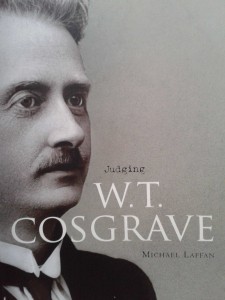JUDGING W.T. COSGRAVE
Published in Book Reviews, Issue 1 (January/February 2015), Reviews, Volume 23 MICHAEL LAFFAN
MICHAEL LAFFAN
Royal Irish Academy
€30
ISBN 9781908996398
A Dublin Opinion cartoon introduces a just-retired William T. Cosgrave to ‘History’ in 1944. Yet it has taken 70 years for the image of the head of the first government of Ireland to re-emerge into the public consciousness. This, the first complete biography by an academic, provides a wealth of insights into a much-neglected actor of history and his agency during a seminal and violent phase of the modern state. The author symbolically points to the recent rediscovery of a long-lost portrait of Cosgrave by Seán Keating; it had been rolled away and forgotten, like its subject, for so long.
Cosgrave had not wanted a biography, kept no journal, and his home and vital documents were burned down by anti-Treatyites in 1923. Being caught between the titanic shadows of the Big Fella and the Chief was clearly one heck of an awkward spot in the Irish story. With none of the swagger and machismo of a Collins, nor the longevity in office and party political ‘metaphysical’ cunning of a Dev, this small and jolly administrator, neither extrovert nor imbued with self-importance, once stated that he had reached his position ‘purely by accident’. The detail demonstrates otherwise. Posterity has somewhat dismissed him as being in the right place at the right time, including that most dramatic of junctures, chairing an emergency meeting at 4am after the news of Béal na Bláth had reached Dublin. Within 48 hours of Collins’s death (Arthur Griffith having also just died), Cosgrave’s ‘cabinet colleagues unanimously elected him as chairman’. When Saorstát Éireann was established in December 1922, he became president of its executive council (or cabinet), i.e. head of government. Reading the earlier chapters of this book, as distinct from the inglorious years in ineffectual opposition duly charted by Laffan, should convince readers that the range of W.T.’s skills and influence has been underestimated. Civil War politics long influenced divisive memories in the public mind, and Cosgrave’s had been the casting vote on the Treaty at the Mansion House. His governments took many tough (and questionable) decisions but did so collectively. Openly, exceptionally, even embarrassingly devout, his deference to the Catholic hierarchy reflected the sentiments of the times in which he lived—perhaps in an extreme form, Laffan suggests, but he was hardly exceptional in this regard. Snippet history is fun but easily misleads: yes, the Irish Times in September 1922 deemed that he looked ‘rather like the general manager of a railway company’ in contrast to a wild-eyed revolutionary. He had a ‘thoroughly conservative face’, but he was to lead a famously conservative government of former revolutionaries. Yet the same piece praised the well-pointed witticism with which he had re-energised his Dáil colleagues; behind the kindly levity, here was also a rock of common sense.
The son of a publican, born in James’s Street in the heart of Dublin, and having completed his formal education at the Christian Brothers by fifteen, W.T. certainly faced stronger personalities. His first public act of nationalism was, aged nineteen, to write to the papers expressing his ‘deepest disgust’ at Queen Victoria’s visit. Elected to Dublin Corporation in 1909 (Usher’s Quay ward), one of only five Sinn Féin members, he worked his way up in local government and gained vital expertise on various committees, hoping to end jobbery and corruption. His abilities recognised by the dominant Home Rule party, in 1915 he was elected chair of the Corporation’s most important committee, finance and estates. Cosgrave had joined Sinn Féin in 1905, the Volunteers in 1913, the IRB never, and was first elected as a Sinn Féin MP for Kilkenny City in 1917. Serving under Eamonn Ceannt, he recalls loading so many rifles into a taxi after Howth that he had trouble shutting the door. Local knowledge of the South Dublin Union proved most useful during the Rising; he was court martialled and expected to be shot, but this was commuted to penal servitude for life. In and out of prison, on the run, then under siege, he set about achieving the political goal for which he had once taken up arms. Prior political experience was uncommon among his associates; he became the first minister for local government in 1919 and set about helping to build a viable state apparatus: ‘Good government is a lot to ask from a relatively poor country and from a people so long divorced from any respect for order’.
This book covers the entire life without favouring the more heroic episodes. Laffan accessed a range of sources and warmly acknowledges the ongoing collaboration of his son, former taoiseach Liam Cosgrave. Is the Judging series élitist hagiography? Laffan aims at impartiality and balance and addresses controversial episodes, e.g. the Emergency Powers (July 1923) and W.T’.s ruthless stance on the executions, divorce, partition, the so-called Blueshirt ‘parenthesis’, the Mayo librarian and that Harry Clarke window, duly reproduced. The core text is relatively short (80,000 words) and cannot dwell on any episode for long. One senses a need to be gracious in the flowing prose, as in effect Laffan is indirectly judging the gap in scholarship; he consistently provides contextualisation on economic, social and cultural issues.
Heavily subsidised, Judging Cosgrave is also affordable, and can provide teachers and students with a wide range of photos, deliciously dated satirical cartoons and facsimiles of documents, some in W.T.’s challenging hand. Statecraft may not have the appeal of fallen heroes, but W.T. Cosgrave’s was the trajectory of a committed patriot who has finally been given the eminent and honourable place he deserves in Irish history.
Reviewed by
Sylvie Kleinman
Sylvie Kleinman has worked for the Dictionary of Irish Biography.
















